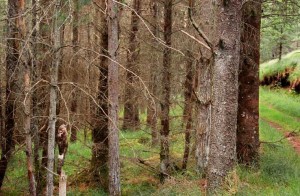 Disposition, part 1 (2003). Photograph by Kate Foster, specimen courtesy of Hunterian Museums and
Disposition, part 1 (2003). Photograph by Kate Foster, specimen courtesy of Hunterian Museums and
Art Galleries (Zoological Section)
ARTIST STATEMENT
“Disposition” concerns a scarce bird of prey, a hen harrier. After it had been killed as ‘vermin’ in a shooting estate in the far north-west of Scotland in the 1920s, a female hen harrier was procured for Glasgow University collection as a cabinet skin. Still heavily persecuted in other areas, these ground-nesting birds are also affected by diminished habitat. I travelled to a remote community with the cabinet skin, learning of the likely circumstances of the bird’s demise. This photograph – within a commercial plantation that now exists at the place of its death – formed part of my re-presentation of this bird’s unique history in the museum.
THE ARTIST
My artwork elicits specific instances of entangled patterns in human and animal coexistence in changing environments. I take account of different kinds of expertise and refer to biological and geographical concerns, but my priority is to make visual artwork engaging undisciplined senses – complex and surprising – offering routes to engage with ecological interconnectedness. ‘Disposition’ was one of a series of ‘Biogeographies’ that generated unique histories of university zoological specimens, which have become joint-works extending ‘animal afterlives’ in human settings. One project focused on a rare and overlooked skull of an extinct South African antelope in the Hunterian Zoology collection. This led to traverses in time and place, holding hope of generative possibilities within a degrading legacy of loss and humiliation (‘Blue Antelope’). Current work is directed at drawing in the field as a means to work ‘in the present tense’ in the rural Scottish Borders, producing ‘sheep-scapes’ and ‘tree-lines’ – creative investigations of land-use, developing sensitivity to ‘changeable places’ and choices that are being made.
Approach to work: An environmental artist working mainly in non-art settings, I find diverse ways to work in public and respond to contexts. Assisted by residencies at Glasgow (UK) and Stellenbosch (South Africa) universities, outcomes have included museum installation, artist bookwork, online catalogue, collaborative academic presentations, multiples and other interventions, with occasional gallery presentation.
VISIT www.meansealevel.net
Fieldwork blog: www.inthepresenttense.net
Biogeographies / Blue Antelope project website: www.blueantelope.info